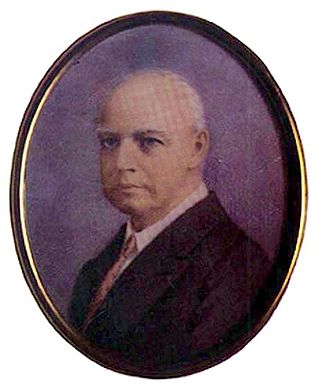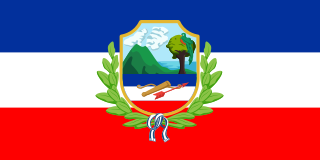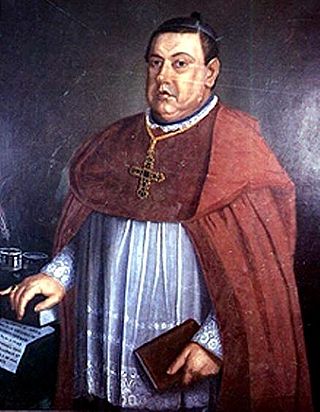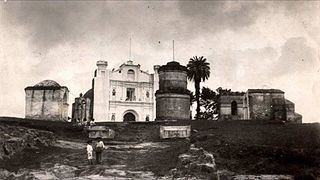
José Rafael Carrera y Turcios was the president of Guatemala from 1844 to 1848 and from 1851 until his death in 1865, after being appointed President for life in 1854. During his military career and presidency, new nations in Central America were facing numerous problems: William Walker's invasions, liberal attempts to overthrow the Catholic Church and aristocrats' power, the Civil War in the United States, Mayan uprising in the east, Belize boundary dispute with the United Kingdom, and the wars in Mexico under Benito Juárez. This led to a rise of caudillos, a term that refers to charismatic populist leaders among the indigenous people.

Manuel Lisandro Barillas Bercián was a Guatemalan general and acting president of Guatemala from 6 April 1885 to 15 March 1886 and President from 16 March 1886 to 15 March 1892. He was born in Quetzaltenango, and assassinated in Mexico City in 1907.

Pedro de Aycinena y Piñol was a conservative politician and member of the Aycinena clan that worked closely with the conservative regime of Rafael Carrera. He was interim president of Guatemala in 1865 after the death of president for life, general Rafael Carrera.

Salamá is a city in Guatemala. It is the capital of the department of Baja Verapaz and it is situated at 940 m above sea level. The municipality of Salamá, for which the city of Salamá serves as the administrative centre, covers a total surface area of 764 km2 with a population of 65,275 inhabitants at the 2018 census.

The State of Los Altos, commonly known as Los Altos, was the 6th state of the Federal Republic of Central America from 1838 to 1840 and a short-lived independent republic from 1848 to 1849. Its capital was Quetzaltenango. Los Altos occupied eight departments in the west of present-day Guatemala as well as the Soconusco region in the Mexican state of Chiapas.

Doroteo Vasconcelos Vides y Ladrón de Guevara was President of El Salvador 7 February 1848 - 1 February 1850 and 4 February 1850 – 1 March 1851. Vasconcelos was close friend of Honduran general Francisco Morazán. He tried to invade Guatemala and defeat general Rafael Carrera on 2 February 1851 but he was defeated. After defeat, he retired from public life.

Mataquescuintla is a town and municipality in the Jalapa department of south-east Guatemala. It covers 262 square kilometres (101 sq mi).

Lorenzo Montúfar y Rivera was a Guatemalan politician and lawyer. Superb leader and speaker, helped the liberal regime of Justo Rufino Barrios, served in the Guatemalan legislature, taught in the College of Law of the Universidad Nacional de Guatemala and, towards the end of his life, was a presidential candidate himself losing to general José María Reyna Barrios. He was also Foreign Secretary of Costa Rica in 1856 and from 1870 to 1873, and President of University of Saint Thomas, also in Costa Rica.

José Batres Montúfar (1809–1844) was a Guatemalan poet, politician, engineer and military figure.

María Josefa García Granados y Zavala was a Guatemalan intellectual, writer, journalist and poet of Spanish origin, and one of the greatest intellectual exponents of the independence of Guatemala, which was achieved in 1821. She was also a feminist ahead of her time, who with her strong and dominant character influenced Guatemalan culture. She was the sister of General Miguel García Granados, who was the first liberal president of Guatemala, and Adelaida García Granados, who was tutor of Petrona Álvarez, wife of General Rafael Carrera, lifelong conservative president of Guatemala. As his family was part of the Aycinena clan, they suffered exile and dispossession of their property by Francisco Morazán in 1829.
Mariano Paredes (1800—1856) was President of Guatemala from January 1, 1849 to November 6, 1851 as a compromise chief of state. Paredes, an army colonel, came to power after Rafael Carrera was ineffective in quelling uprisings in eastern Guatemala and short-term governments failed to restore order. But Mariano Paredes was unable to control Guatemala.

Mariano Rivera Paz was Head of State of Guatemala and its first president.

Juan José de Aycinena y Piñol was an ecclesiastical and intellectual conservative in Central America. He was President of the Pontifical University of San Carlos Borromeo from 1825 to 1829 and then of the Universidad Nacional from 1840 to 1865. He was a thinker criticized by liberal historians for his strong relationship with the conservative government of General Rafael Carrera and for eliminating the possibility of getting the Central American Union which the Liberals wanted. His participation in the government has been assessed more objectively in research conducted between 1980 and 2010. He was heir in 1814 to the noble title of III Marquess of Aycinena, and bishop in partibus of Trajanopolis from 1859. He had a taste for law, oratorical talent and wrote over twenty works.

Vicente Cerna y Cerna was president of Guatemala from 24 May 1865 to 29 June 1871. Loyal friend and comrade of Rafael Carrera, was appointed army's Field Marshal after Carraera's victory against Salvadorian leader Gerardo Barrios in 1863. He was appointed Carrera's successor after the caudillo's death in 1865 even though Guatemalan leaders would have preferred Field Marshal José Víctor Zavala.

Luis Batres Juarros or Luis Batres y Juarros was an influential conservative Guatemalan politician during the regime of General Rafael Carrera. Member of the Aycinena clan, was in charge of writing most of the legislation that was enacted during this period. The liberal historians portray him as a villain in a despotic and tyrannical government headed by illiterate Raca Carraca - Rafael Carrera - who was taking each and every one of Batres recommendations since he was considered infallible; However, research conducted between 1980 and 2010 has shown a more objective biography of both Batres and Rafael Carrera and show that it was in fact Carrera who had the reins of the Conservative government.

Agustín Guzmán López, nicknamed "The Altense Hero", was a liberal Central American military general, politician and positivist, who was appointed as Army Commander in Chief of the State of Los Altos when it was formed as part of the Federal Republic of Central America on March 2, 1838. He was defeated by Rafael Carrera on March 19, 1840, and Los Altos was re-annexed by Guatemala. Trying to re-establish Los Altos once again while Carrera was briefly in exile in 1848, he tried to occupy Guatemala City along with rebel leader Agustín Reyes, and after setting fire to Carrera's house, he was killed by enemy fire in the Plaza de Armas.

Manuel Francisco Pavón Aycinena was a conservative Guatemalan politician during the regime of General Rafael Carrera. He was influential in the founding of the government's executive branch and held several Cabinet offices during his career.

Mariano de Aycinena y Piñol was wealthy and influential Guatemalan merchant family and an important conservative politician. A younger son of the first marquis of Aycinena, peninsular-born Juan Fermín de Aycinena (1729–1796), Mariano was a leader of Guatemalan independence from Spain. He served governor of the State of Guatemala in the Central American Federation from 1 March 1827 to 12 April 1829 and patriarch of the Aycinena family. The family had the commercial monopoly in Central American during the Spanish colonial era later year thanks to the Consulado de Comercio. He was one of the signatories of Central American independence and lobbied heavily for the annexation of Central America to the Mexican Empire of Agustín de Iturbide. This arrangement would keep the family's economic position and privileges following independence. After being expelled along with the Aycinena family in 1829 after being defeated by Francisco Morazán, went into exile in the United States and then to Mexico. He came back to Guatemala after the conservatives had allied with general Rafael Carrera; but then he retired from public life and hand the Aycinena family leadership to Juan José de Aycinena y Piñol.

Human settlement on the present site of Guatemala City began with the Maya who built a city at Kaminaljuyu. The Spanish colonists established a small town, which was made a capital city in 1775. At this period the Central Square with the Cathedral and Royal Palace were constructed. After Central American independence from Spain the city became the capital of the United Provinces of Central America in 1821.

The Totoposte Wars were three military conflicts fought in Central America between 1890 and 1906. The First Totoposte War occurred during the presidency of Manuel Lisandro Barillas Bercián in Guatemala, after the overthrow of Salvadoran President Francisco Menéndez by General Carlos Ezeta in El Salvador, which caused the exile of many Salvadorans who took refuge in Guatemala and who requested the help of President Barillas Bercián to stop the armies of Ezeta. The Second Totoposte War arose after the opposition of Guatemalan President Manuel Estrada Cabrera to the integration of Guatemala with the Greater Republic of Central America since Estrada Cabrera was more inclined to work with the government of the United States. The Third Totoposte War occurred in 1906 in similar conditions. In all three wars, the Guatemalan people mockingly referred to the war as the "Totoposte War" because it only served to consume large amounts of this corn-based food, without actually fighting.

























